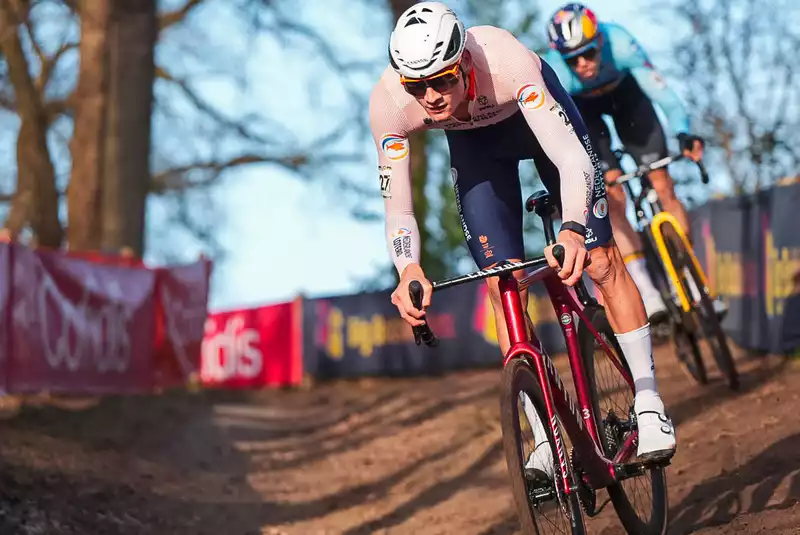Those who watched the World Cyclocross Championships over the weekend will have noticed the spectacular footage of Mathieu van der Pol and Wout van Aert following from above as they raced through the forested sections of the Hogelheide course.
Cyclocross coverage relies on a series of fixed cameras set up along the course. However, the drone footage used on Sunday was more than a novelty. The drones eliminated blind spots on the course, bringing viewers closer to the riders than ever before and providing a new perspective on the two lifelong rivals vying for the rainbow jersey.
The machine was operated by Jan Crommelink, a former Belgian motocross racer who turned to drones from his hobby of flying model airplanes after suffering a heart attack.
Crommelinck started with motocross racing, photographed cyclocross during the COVID-19 pandemic, and counts Formula 1 teams Ferrari and Red Bull among his clients.
"I've been doing this for 12 years as my main career. For me, it's like riding a bike," Kronmelink told Sporza (open in new tab) after the World Championships. It's been a great experience. Fortunately, most of them were positive.
"Mentally, I was flying with the athletes on the course. Especially when I followed Wout and Mathieu. I felt the adrenaline and the excitement."
The drone he uses is custom built to be ultralight for speed and agility. The battery is very small, lasting only four minutes. The camera is a Blackmagic pocket camera taken apart.
Kronmelink's first encounter with UCI racing was a year ago, when she surprised the commentators by expertly flying behind Lucinda Brand in the Superprestige Gavère.
"The UCI thought it was a regular drone and stopped us," Kronmelink recalled to Cycling News. The stunning sink shot that followed the brand may have been the tipping point for UCI to allow drones." Now they have given us the opportunity to use drones. But there was only one rule: stay three to five meters away from the rider. That was the only rule I had to respect."
Filming the battle between the two world championship rivals was somewhat complicated by the riders, the packed crowd of 38,000 spectators, and the dangers of the forest section.
He and spotter Tim Verbruggen had to stay away from the crowd, maintain a certain distance from the riders, and stay in view at all times while the 1.5 kg drone was in the air.
"There are strict regulations," Kronmelink said. 'You can't fly over public airspace. At Hogelheide, parts of the track could be closed to the public. So we could fly next to the circuit without the public."
Kronmelink and his company Aeroplayfilms have worked with major clients in film, commercials, and action sports, but the World Championships stood out.
"Because the race with Mathieu and Wout was a very big battle. There is no room for mistakes. There's no room for mistakes. I tried to stay calm, but at the end when I went into the forest with them it was like I was in the race too. I had to stay calm, but the crowd was yelling. So it was hard to stay focused."
The footage provided by Kronmelink and his drone was spectacular and added a new dimension to the race viewing experience, but will viewers ever see something similar on the road? Scenarios that come to mind include Tom Pidcock's descent of the Col du Galibier at the Tour de France and Matej Mohoric's dropper post-poggio attack at Milan-San Remo.
Both have been and seemingly must continue to be well filmed by the traditional means of motocameras and helicopters.
Regulations governing the use of drones mean that they must be kept away from large crowds, out of the way of competitors, and always in view of the operator.
Crommelinck explained that because there are too many spectators along the course at the major road races, he is restricted from flying over the public and cannot film these races unless the organizers close part of the road.
Therefore, we will not be able to see his drone footage until after the next cyclocross season for now. Maybe they are gearing up for the mountain bike Olympics in Paris next year. Maybe all the organizers need to close down some of the courses. That way we can have more races. I think we proved at Vogelheide that it is possible to fly safely. It has to be safe. I think we proved that last weekend
Speaking to CyclingWeekly (opens in new tab) last year, Will Glover, a drone pilot for aerial photography company Flying Pictures, said that regulations on drone use are a problem and so is the technology currently available. technology as well, he said.
"In bicycle racing, it is very difficult because of the distance and lack of visibility due to trees, tunnels, and mountains, and the risk of drone pilots losing control of their drones and compromising flight safety," he said, noting that flying over large crowds is not permitted by aviation authorities and He also noted that flying over large crowds is not permitted by aviation authorities.
"Most drone maneuvers are called visual line-of-sight maneuvers, which require the pilot to be looking at the drone at all times. More risk-reducing, the pilot can control the drone using a safety aid, such as a spotter with binoculars, to keep the drone safe.
"Bicycle racing is very difficult because of the distance and loss of line of sight due to trees, tunnels, and mountains, and the risk that the drone pilot may not be able to control the drone and compromise the safety of the flight.
"A lot needs to change if we are going to be able to use drones to capture the action in road races like the Tour de France," Grover concluded.
.

Comments